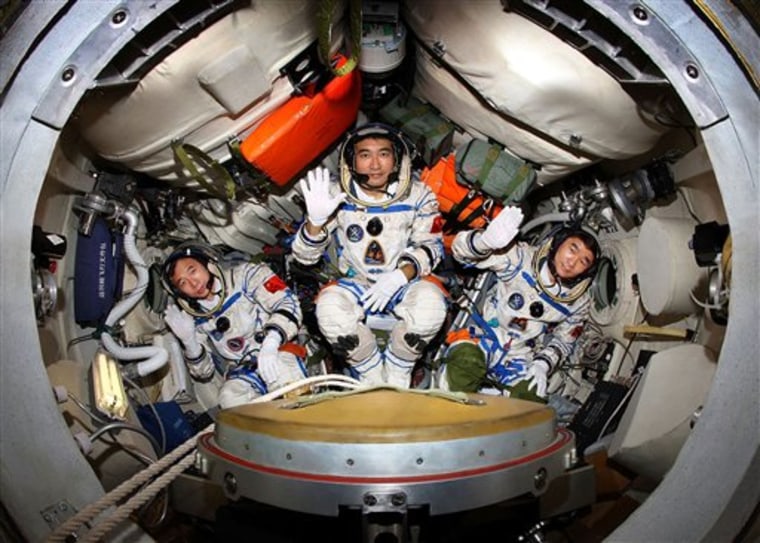China's three-man spacecraft shifted from an oval orbit to a more stable circular orbit 213 miles above Earth on Friday in preparation for the country's first attempt at a spacewalk.
The spacewalk is scheduled to take place at about Saturday afternoon, although the exact timing depends on the readiness of equipment and personnel, said Wang Zhaoyao, deputy director of China's manned space program office. The event will be broadcast live on television, he said.
"This is China's first attempt (at a spacewalk) so there are a lot of uncertainties," Wang said.
He said the three astronauts were assembling and testing their space suits in preparation for the spacewalk, which is to last about 20 minutes.
The Shenzhou 7 mission, China's third manned space voyage, blasted into space atop a Long March 2F rocket on Thursday.
The launch was broadcast live on state television in a display of China's growing confidence in its space program. Shortly before the feed ended, one of the crew reported that they were all well and had extended the craft's solar panels.
The launch dominated front pages of the entirely state-controlled media, largely supplanting coverage of China's continuing scandal involving contaminated milk.
The Communist Party's flagship newspaper People's Daily showed President Hu Jintao waving to the astronauts before the launch and congratulating staff at mission control after liftoff.
Slideshow 12 photos
Month in Space: January 2014
Such coverage underscores the weighty role of politics and patriotism in the space program, officially presented as an illustration of China's rising technological might and global influence.
The official Xinhua News Agency said the astronauts executed a 64-second engine burn to shift the spaceship from an oval-shaped orbit into a round one, meaning it was circling Earth at a constant distance.
The change in orbit ensures Earth's gravitational pull will not vary during the spacewalk attempt, and will allow for smooth operation of the ship's instruments, the agency said.
A round orbit will also help Shenzhou make a precise landing on the Inner Mongolian Steppe on Sunday after its re-entry vehicle bursts through Earth's atmosphere, Xinhua said.
The mission is devoted almost entirely to the execution of the spacewalk, a key step in mastering techniques for docking two orbiters to create China's first orbiting space station.
The two astronauts who will don space suits for the spacewalk will be supported by Russian experts throughout the mission. Only one will actually leave the orbiter module to retrieve scientific experiments placed outside, described by Xinhua as solid lubricant samples. They will then release an 88-pound satellite which will circle the orbiter and send back images.
Shenzhou 7 commander Zhai Zhigang is touted as most likely to carry out the spacewalk. All three astronauts are 42-year-old fighter pilots with more than 1,000 hours of flying time.
China's last manned mission, Shenzhou 6, came in 2005, two years after the country first put a person into orbit.
The chief designer of the Shenzhou spacecraft said Friday that China's space program would speed up production of the next generation of Shenzhou craft, indicating that the country's 16-year-old manned spaceflight program was gathering pace.
Zhang Bainan offered no numbers, but said the spacecraft would be used to transport astronauts and cargo to a future Chinese space station. Zhang said other countries might be offered space on the craft.
Ramped-up production of the three-module Shenzhou, based loosely on Russia's Soyuz capsule, also points to a need for more astronauts beyond the 14-member corps now trained.
To meet the demand, a new round of astronaut selection will be held using revised standards following completion of this year's mission, Chen Shanguang, director of the China Astronaut Research and Training Center, was quoted as saying by the Communist Party's China Youth Daily newspaper.
Officials are drafting specific criteria for female astronauts, although no schedule for recruitment has been set, China's first astronaut, Yang Liwei, now Chen's deputy, was quoted as saying.
"Many standards have already been set and there has been strong support from society as a whole," Yang said.

